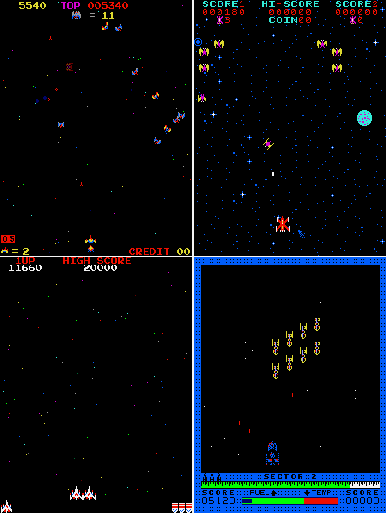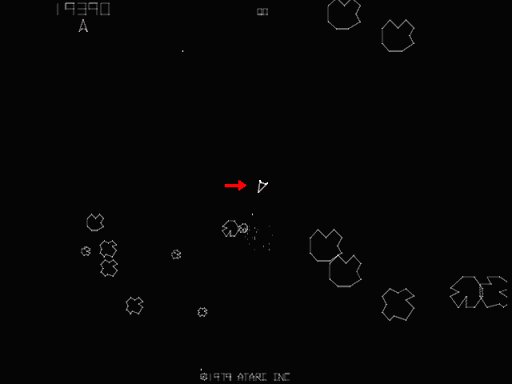Shooter Gallery #8: The Special Ability
There are many ways to expand on the basic shoot 'em up formula originally laid down by Space Invaders, some more obvious than others. Giving the player special abilities is one way to add dimensions to the gameplay and, if it's well designed, increase replayability. Here I'm going to look at some of the specific abilities that were offered to player in fixed-screen shoot 'em ups in the first three years following Space Invaders.
Hyperspace
One of the first special abilities to appear in early shoot 'em ups was in Asteroids. If the player senses they are in danger, either from converging asteroids or attacking UFOs, they can push the "hyperspace" button and be immediately transported to another part of the playing field. Unfortunately, there's no guarantee that you'll be transported to a location that's any safer than where you started.
The hyperspace ability amounts to a sort of panic button randomizer. If you know you're about to bite the dust, then there's no harm in taking the chance, but otherwise you're best off leaving it be. As such, its strategic value is limited and its use is less a matter of thought than instinct. The feature would be used again in some contemporary games, such as Defender and Astrosmash, but is now difficult to come by in the wild. Asteroids was a success, to be sure, but I suspect it would have done just fine with or without this feature.
Shields
What if, instead of transporting the player, you simply allowed them to become invulnerable for a moment? That's the idea behind the shield in Phoenix, which can be used to make yourself invulnerable for one second. You can't move while it's active and there's a three-second cooldown before you can use it again, but it's certainly useful in a pinch. Unfortunately, it comes with risks similar to those of hyperspace.
The fact that you're frozen in place while the shield is on is especially dangerous in a game like Phoenix, where the enemies move so erratically that there's really no way to predict where they'll be when your shield deactivates. So again, it acts like a sort of emergency randomizer, though it's less risky than hyperspace.
Slowdown
It has a very small footprint today, but in 1981, one of the most popular games to imitate was Sega's Astro Blaster. It had a direct clone (Century's Cosmos) and multiple unofficial home computer adaptations (e.g., Threshold and Sneakers).
The concept is very simple: you shoot your way through as many waves of aliens as you can, trying not to run out of fuel or overheat your blaster. The blast heat meter effectively limits the player's firing rate, which is a clever way to enforce shot efficiency. The player can't afford to just fire wildly or they'll end up without a blaster for a short period, and that could be enough to cause them to run out of fuel before the next checkpoint.
Astro Blaster also gives the player a special ability that they can use once between each refuel point. With the push of a button, you can cause all of the enemies to go into slow motion for a period of 14 seconds, making them sitting ducks for your blaster. This is especially handy for the enemies with stuttery movement, which are hard to take down without a barrage of shots.
The slowdown is a useful feature in Astro Blaster, and works well in the context of a game focused on shot efficiency. But shoot 'em ups are action games, and slowing down the action is the opposite of what most gamers are looking for.
Warp Mode (Space Firebird)
The first use of an offensive special ability that I can find in a shoot 'em up is in Nintendo's Space Firebird (1980). Although thematically indebted to Phoenix, the design of Space Firebird is less clearly structured. A continuous flow of enemy groups enter the playing field, sometimes with all four enemy types attacking at once. Their movements are highly coordinated, however, often forming wide arcs across the screen that presage the sweeping enemy trains of Galaga.
Once per wave (or life), Space Firebird gives you the option of going into warp mode. While in this state, you move slowly forward across the screen, destroying anything you come into contact with. It's impossible to know exactly where the enemies will be when you get to the top half of the screen, but if you're anticipating that a lot of enemies are about to enter the field, this can be a good way to dispense of them quickly.
Double Fighters (Galaga)
It's not exactly a special ability in the same sense as the other games discussed here, but Galaga includes a feature where the player can "rescue" one of their own ships, and then attack with both ships at once.
If you're willing to let one of your ships get captured, the double hots can be handy for racking up points in the early going, particularly in the bonus rounds. Of course, it also makes you a much bigger target for the enemies, so depending on your level of experience, it may or may not be worth the risk.
Galaga actually wasn't the first game to allow the player to fire two bullets at a time. In 1980's Moon Cresta, the player controls three different kinds of ships, one for each of their lives. Two of these ships have double-barrelled weapons.
Again, this is not a special ability or a power-up, since you actually have to lose a life to access the ships with double firing, and that's not something a player will want to do intentionally. Still, it adds variety to the gameplay, something that most early shoot 'em ups were sorely lacking.
The Big Picture
One of the most remarkable things about the "special abilities" in early fixed-screen shoot 'em ups (1978-1981) is how few of them there are. Despite a wide range of experiments in geometry, enemy behavior, boss battles, and even defensive mechanics, the player was almost always working with a single fire button and nothing more. Certainly, the industry had long been gravitating towards simple designs, but it should have been clear from the success of Asteroids that arcade-goers were not completely averse to a complex interface.
Fortunately, at least one early shoot 'em up designer was willing to buck the trend. In a forthcoming entry, I'll take a detailed look at Defender, including its incorporation of special abilities into the gameplay.











Yes , and then came Defender which had more in common with an Apollo Command Module panel - looked pretty intimidating to me as a kid.
ReplyDeleteInteresting! I played asteroids as a kid with atari console version. I do remember the teleport ability. Eventually, the "bomb" special ability wiping out all the enemies on screen became the staple ability in future shmups.
ReplyDeleteMoon Cresta also allowed you to dock your three ships if you survived long enough, letting you eventually control a giant behemoth firing five bullets at a time.
ReplyDeleteAsteroids Deluxe had shields like Phoenix, but very much not like Phoenix. You controlled when it disengaged, though it had a time limit per round, and you could move but not fire rather than the other way around.
I also just recalled Space Fury, where every level you can dock with a "shell" that gives you extra firepower - one fires two extra shots forwards, one fires two shots backwards, one fires a shot to each side. The shell you choose third is your shell for the rest of the game.
I just found this blog today, and I'm really enjoying it. Expect many more comments from me. :D